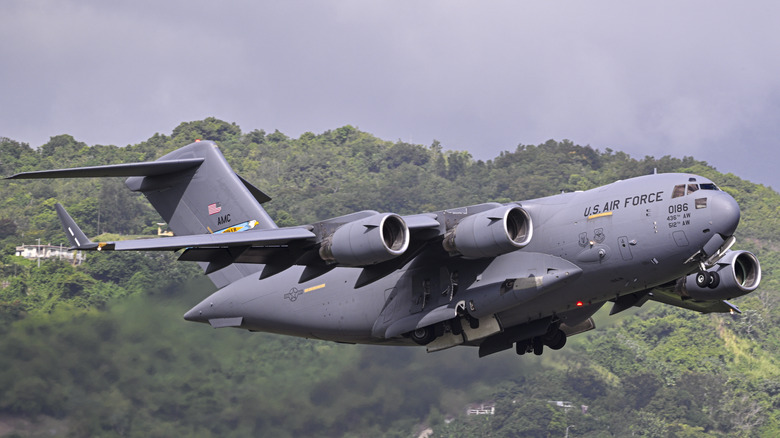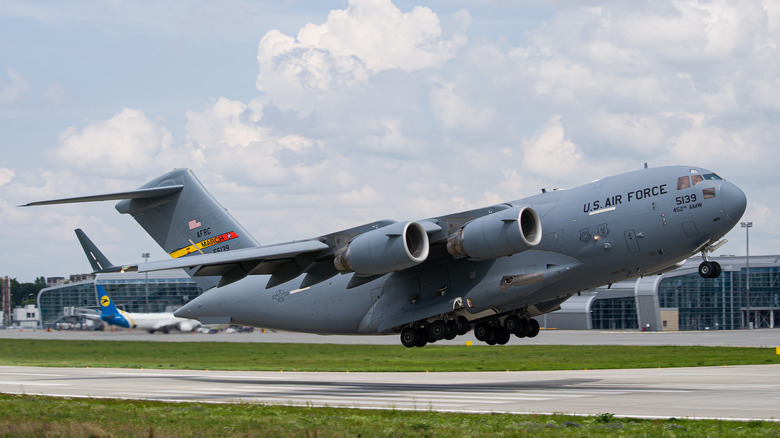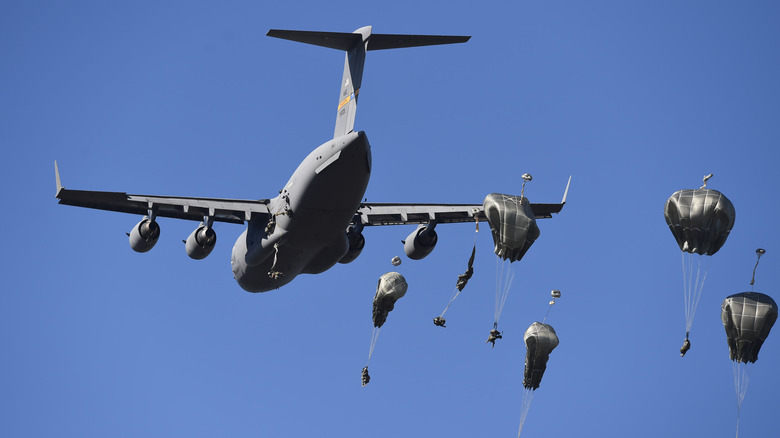Why The U.S. Military Can't Replace Its Aging C-17 Globemaster Just Yet
The C-17 Globemaster III isn't as old as planes like the famously ancient (yet still remarkably effective) B-52 Stratofortress, but it's still getting to be a little long in the tooth, as it has been in consistent service with the United States since 1993. Despite eclipsing 30 years old, it's still going strong and will likely see service into the 2040s. While aircraft manufacturers are always innovating and working on what's next to fly in combat zones, the C-17 doesn't seem like it's going to have a replacement anytime soon.
Is the C-17 Globemaster the ultimate case of "If it ain't broke, don't fix it?" Or is it a little more nuanced than that? While other planes like the Airbus A400M do a similar job to the C-17, and giants like the C-5 Galaxy can carry much more cargo around the world, the C-17 itself has a unique set of capabilities that make it quite possibly the best plane for the job. The United States Air Force bills the C-17 as "The most flexible cargo aircraft to enter the airlift force." There simply isn't a replacement for this cargo plane in America's inventory.
The best plane for the job
First and foremost, the C-17 is a cargo plane, meaning its primary job is to carry people or things to and fro. As such, its maximum cargo capacity is 170,900 pounds, or if the mission requires, 102 fully equipped paratroopers. For a little perspective, a 2025 Ford F-150 has a maximum payload of 2,440 pounds. Another widely used military cargo plane, the Airbus A400M has a maximum cargo capacity of 81,600 pounds.
Additionally, the C-17 is designed to take off from relatively short runways and, thanks to its thrust reversers, can maneuver in tight spots. Boeing, the plane's manufacturer and servicer, built the C-17 to land on a 3,000-foot-long runway. That sounds long, but when you consider the fact that most major airports have a 10,000-foot (or more) runway, you get a better perspective as to what the C-17 is capable of. The C-17 is a 174-foot-long cargo plane that can drop an M1 Abrams tank just about anywhere it will fit.
As mentioned earlier, the United States also uses the much larger C-5 Galaxy. It's a behemoth of a plane. The C-5M Super Galaxy can carry 281,000 pounds, much more than the C-17. However, its sheer size at a length of 247 feet makes it harder to fit into places where the C-17 can venture. Additionally, the design is much older, first coming into service in 1970. Those factors make it an unlikely choice to replace the C-17.
No competition
As of now, there are only two other planes that can do a similar job as the C-17, in terms of cargo capacity and general role. Those planes are the Russian Ilyushin Il-76 and the Chinese Xi'an Y-20, and given the contentious relationship between those two countries and the United States, it's unlikely Uncle Sam is going to replace the C-17 with a Russian or Chinese cargo plane. Still, the Il-76 and Xi'an Y-20 are quite capable in their own respective rights, but fall short of the C-17.
The Ilysushin has a maximum cargo capacity of 47,000 kilograms (103,617 pounds) according to the United States Army. The Chinese Y-20 can carry more at 66,000 kilograms (145,505 pounds) and both can carry over 100 paratroopers.
While other cargo jets are good and flexible for the job, no one has come up with another jet quite like the C-17. It can land just about anywhere and carry just about anything. The United States doesn't need to shop around.


